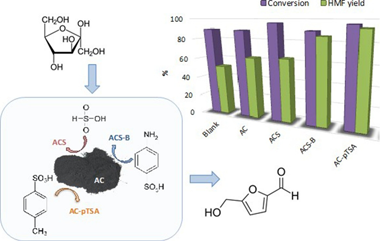Artículos SCI
2021
2021
Tribología y Protección de Superficies - Materiales Ópticos Multifuncionales
High-temperature solar-selective coatings based on Cr(Al)N. Part 1: Microstructure and optical properties of CrNy and Cr1-xAlxNy films prepared by DC/HiPIMS
Rojas, TC; Caro, A; Lozano, G.; Sanchez-Lopez, JCSolar Energy Materials and Solar Cells, 223 (2021) 110951
Show abstract ▽

In order to explore the potentialities of Cr1-x(Al)xNy materials in multilayer-based solar selective coatings (SSC) for high temperature applications (T > 500 °C), the optical behavior of Cr1-x(Al)xNy films is studied in this work. Two sets of layers (CrNy and Cr1-xAlxNy) were prepared by direct current (DC) and high-power impulse magnetron sputtering (HiPIMS) technology. The deposition parameters: N2 flux, HiPIMS frequency and aluminum sputtering power, were modified to get a wide variety of stoichiometries. The composition, morphology, phases and electronic structure of the films were characterized in depth. The optical behavior was determined by UV–Vis–NIR and FTIR spectroscopies, and the optical constants were obtained from the measured transmittance and reflectance spectra based on appropriate dielectric function models. Our results indicate that small changes in the layer composition influence the optical constants. In particular, a metallic-like behavior was obtained for CrNy layers with N vacancies (CrN0.95 and CrN0.67 films) while a semiconductor-like behavior was observed for CrN1.08. Thus, the CrNy films can be used as effective absorber layer in multilayer-based SSC, and namely, the CrN0.67 film as an IR reflector/absorber layer too. Likewise, the optical properties of Cr1-xAlxNy layers can also be tuned from metallic to semiconductor-like behavior depending on the chemical composition. Indeed, the absorption coefficients of Cr1-xAlxNy films with optimized Al content and N-vacancies are comparable to those reported for state-of-the-art materials such as TiAlN or TiAlCrN. In addition, a Cr0.96Al0.04N0.89 film was found to be a suitable IR reflector/absorber layer.
Mayo, 2021 | DOI: 10.1016/j.solmat.2020.110951
Reactividad de Sólidos
Synthesis and Characterization of a Nearly Single Bulk Ti2AlN MAX Phase Obtained from Ti/AlN Powder Mixture through Spark Plasma Sintering
Salvo, C; Chicardi, E; Poyato, R; Garcia-Garrido, C; Jimenez, JA; Lopez-Pernia, C; Tobosque, P; Mangalaraja, RVMaterials, 14 (2021) 2217
Show abstract ▽
MAX phases are an advanced class of ceramics based on ternary carbides or nitrides that combine some of the ceramic and metallic properties, which make them potential candidate materials for many engineering applications under severe conditions. The present work reports the successful synthesis of nearly single bulk Ti2AlN MAX phase (>98% purity) through solid-state reaction and from a Ti and AlN powder mixture in a molar ratio of 2:1 as starting materials. The mixture of Ti and AlN powders was subjected to reactive spark plasma sintering (SPS) under 30 MPa at 1200 degrees C and 1300 degrees C for 10 min in a vacuum atmosphere. It was found that the massive formation of Al2O3 particles at the grain boundaries during sintering inhibits the development of the Ti2AlN MAX phase in the outer zone of the samples. The effect of sintering temperature on the microstructure and mechanical properties of the Ti2AlN MAX phase was investigated and discussed.
Mayo, 2021 | DOI: 10.3390/ma14092217
Química de Superficies y Catálisis
Effect of the sulphonating agent on the catalytic behavior of activated carbons in the dehydration reaction of fructose in DMSO
Bounoukta, CE; Megias-Sayago, C; Ivanova, S; Penkova, A; Ammari, F; Centeno, MA; Odriozola, JAApplied Catalysis A-General, 617 (2021) 118108
Show abstract ▽

A series of -SO3R functionalized activated carbons (R=H, O, aryl) were prepared and applied in fructose dehydration reaction to 5-hydroxymethylfurfural. Different sulphonating methods introduce groups on catalyst surface with distinct donor-acceptor and hydrophilic properties. Their nature influences significantly not only activated carbon?s textural and chemical properties but also the product yields and selectivity in fructose dehydration reaction. The viability of the solvent free reaction was also investigated and compared to the performance of the catalyst series in presence of DMSO, where the best catalytic results were obtained.
Mayo, 2021 | DOI: 10.1016/j.apcata.2021.118108
Materiales para Bioingeniería y Regeneración Tisular
Nanofibrous Matrix of Defined Composition Sustains Human Induced Pluripotent Stem Cell Culture
Borrego-Gonzalez, S; de la Cerda, B; Diaz-Corrales, FJ; Diaz-Cuenca, AACS Applied Bio Materials, 4 (2021) 3035-3040
Show abstract ▽

Human induced pluripotent stem cells (hiPSCs) represent the most promising biological material for regenerative medicine applications. In this work, a 3D solid nanofibrous matrix of defined composition (Colamigel-S) consisting of 97 wt % gelatin, 2.6 wt % atelocollagen, and 0.4 wt % laminin has been reproducibly processed and characterized and exhibits a homogeneous nanofibrillar network of high surface area, interconnected microcavities, and typical D-periodic collagen fibril nanostructural features. The purpose of the study was to test the performance of Colamigel-S as substrate for in vitro hiPSCs culture, finding that these cells efficiently attach and grow keeping their characteristic stem morphology and undifferentiated state.
Abril, 2021 | DOI: 10.1021/acsabm.0c00425
Química de Superficies y Catálisis
Fructose dehydration reaction over functionalized nanographitic catalysts in MIBK/H2O biphasic system
Martin, GD; Bounoukta, CE; Ammari, F; Dominguez, MI; Monzon, A; Ivanova, S; Centeno, MACatalysis Today, 366 (2021) 68-76
Show abstract ▽

A series of functionalized nanographitic carbons is prepared, characterized and tested in fructose dehydration reaction to 5-hydroxymethylfurfural. The functionalization treatment was selected to introduce various Bro?nsted acid sites and to modify the textural and catalytic properties of the initial carbon material. Within the series, the sulfonated carbons present the most interesting catalytic behavior resulting in important selectivity to the desired product once the reaction variables were properly adjusted.
Abril, 2021 | DOI: 10.1016/j.cattod.2020.03.016
- ‹ anterior
- 87 of 420
- siguiente ›














